Which of the following is not composed of hyaline cartilage?
- Costal cartilages
- Intervertebral discs
- Respiratory cartilages
- Nasal cartilages
B
Match the following: Nasal cartilage
- Connects the ribs to the sternum
- Covers the ends of most bones
- Forms the skeleton of the larynx
- Supports the external nose
D
Yellow marrow is useful as __________.
- a calcium reserve
- a tissue that may revert back to red marrow if a person needs more red blood cells
- a red blood cell reserve
- a cartilage reserve
B
The bones in the long axis of the body make up the __________.
- long bones
- trabeculae
- appendicular skeleton
- axial skeleton
D
Which of the following is true with respect to hyaline cartilage?
- Most abundant skeletal cartilage
- Located in the external ear and epiglottis
- Better able to stand up to repeated bending
A
Match the description to the correct function of the skeletal system: Mineral storage
- Encloses brain and other soft organs
- Calcium phosphate repository
- Blood cell production
- Site of attachment for skeletal muscles
B
Match the description to the correct function of the skeletal system: Hematopoiesis
- Calcium phosphate repository
- Site of attachment for skeletal muscles
- Blood cell production
- Encloses brain and other soft organs
C
Collagen fibers do not __________.
- provide for bone hardness
- provide tensile strength to bone
- provide resistance to stretching forces on bone
- provide resistance to twisting forces on bone
A
Bones serve as an important reservoir of __________.
- protein
- glucose
- vitamin A
- cholesterol
- calcium
E
Match the following: Articular cartilages
- Covers the ends of most bones at moveable joints
- Supports the external nose.
- Connects the ribs to the sternum
- Forms the skeleton of the larynx
A
Which of the following sites is the site where bone marrow is routinely sampled in an adult?
- the sternum
- the head of the humerus
- the diaphysis of long bone
- the diploe of the skull bones
A
At the end of secondary ossification, hyaline cartilage can be found __________.
- where yellow marrow is produced
- in the medullary cavity
- at the epiphyseal plates
- where red marrow is produced
C
The menisci of the knee are made of __________.
- elastic connective tissue
- fibrocartilage
- hyaline cartilage
- dense connective tissue similar to ligaments and tendons
B
Which of the following bones belong to the axial skeleton?
- Bones of the shoulder
- Leg bones
- Arm bones
- Ribs
D
The bones of the skeleton store energy reserves as fat in __________.
- yellow marrow
- the ground substance
- red marrow
- spongy bone
A
Correctly match the definition and term: Cartilage cells
- Osteocytes
- Osteoblasts
- Chondrocytes
- Hematopoiesis
- Spongy bone
C
Match the description to the correct function of the skeletal system: Movement
- Blood cell production
- Calcium phosphate repository
- Site of attachment for skeletal muscles
- Encloses brain and other soft organs
C
Match the following: Costal cartilages
- Covers the ends of most bones
- Forms the skeleton of the larynx
- Connects the ribs to the sternum
- Supports the external nose.
C
Match the description to the correct function of the skeletal system: Protection
- Blood cell production
- Calcium phosphate repository
- Site of attachment for skeletal muscles
- Encloses brain and other soft organs
D
Correctly match the definition and term: Blood cell formation
- Chondrocytes
- Osteoblasts
- Hematopoiesis
- Spongy bone
- Osteocytes
C
Match the following: Respiratory cartilages
- Forms the skeleton of the larynx and reinforces other respiratory passages
- Covers the ends of most bones
- Connects the ribs to the sternum
- Supports the external nose.
A
Match the type of cartilaginous feature to the correct description: Elastic cartilage
- Able to withstand heavy loads and absorb shock
- Most abundant skeletal cartilage
- Located in the external ear and epiglottis
C
Match the type of cartilaginous feature to the correct description: Fibrocartilage
- Able to withstand heavy loads and absorb shock
- Most abundant skeletal cartilage
- Located in the external ear and epiglottis
A
Cartilage forming cells in the surrounding pericardium secret new matrix _________ the external face of the ______ cartilage tissue
- against, new
- within, new
- against, exsisting
- within, new
C
The lacunae-bound chondrocytes ______and secrete new matrix, expanding the cartilage from _______.
- divide, within
- divide, outside
- die, within
- die, outside
C
Correctly match the term and description: Diaphysis
- Secondary ossification center
- Primary ossification center
- Site of length increase in long bones
- Process of long bone development
B
Match the following descriptions of the important functions of bone: Hormone production
- Supports the body and cradles its soft organs
- Helps to regulate insulin secretion, glucose homeostasis, and energy expenditure
- Surrounds the brain, spinal cord, and heart
- As a result, we can walk, grasp objects, and breathe
- A source of energy for the body, is stored in bone cavities
B
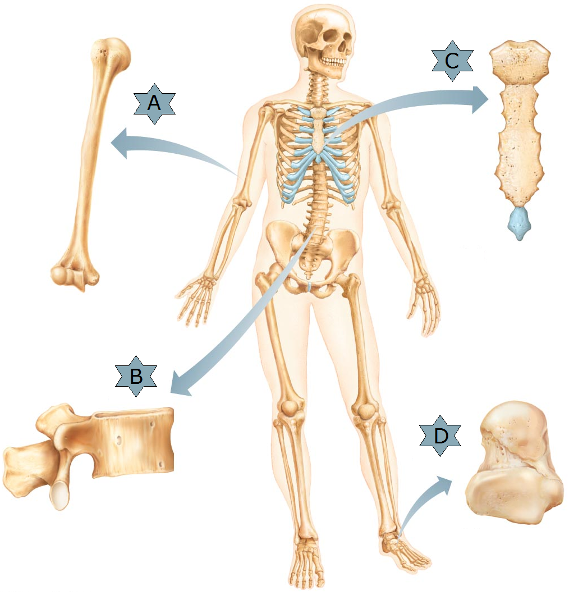
Identify the general class of bone indicated by "A."
- Long bone (humerus)
- Flat bone (sternum)
- Short bone (talus)
- Irregular bone (vertebra)
A
Match the description to the correct answer: Has a length greater than width
- Long bone (humerus)
- Flat bone (sternum)
- Short bone (talus)
- Irregular bone (vertebra)
A
Match the description to the correct answer: Approximately equal in length and width
- Long bone (humerus)
- Flat bone (sternum)
- Short bone (talus)
- Irregular bone (vertebra)
C
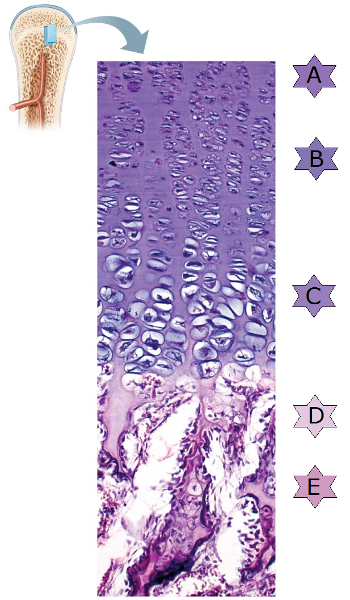
Identify the stage of long bone growth at the epiphyseal plate indicated by "B."
- Hypertrophic zone
- Calcification zone
- Proliferation zone
- Ossification zone
C
Correctly match the definition and term: Short bone
- Sternum of breastbone
- Carpals of wrist
- Femur of the leg
- Patella of knee
- Vertebrae of spinal column and hip bones
B
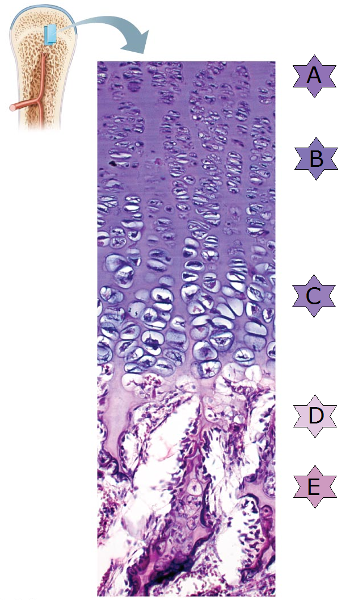
Identify the stage of long bone growth at the epiphyseal plate indicated by "D."
- Hypertrophic zone
- Calcification zone
- Proliferation zone
- Ossification zone
B
Correctly match the definition and term: Fibrous connective tissue membrane that covers the outer surface of long bone
- Periosteum
- Diaphysis
- Epiphysis
- Endosteum
- Medullary cavity
A
Match the following descriptions of the important functions of bone: Anchorage
- Helps to regulate insulin secretion, glucose homeostasis, and energy expenditure
- Surrounds the brain, spinal cord, and heart.
- Supports the body and cradles its soft organs
- As a result, we can walk, grasp objects, and breathe
- A source of energy for the body, is stored in bone cavities
D
Match the description to the correct function of the skeletal system: Hematopoiesis
- Calcium phosphate repository
- Site of attachment for skeletal muscles
- Blood cell production
- Encloses brain and other soft organs
C
Correctly match the definition and term: Sesamoid bone
- Vertebrae of spinal column and hip bones
- Patella of knee
- Femur of the leg
- Carpals of wrist
- Sternum of breastbone
B
Match the description to the correct answer: Approximately equal in length and width
- Sesamoid bone
- Short bone
- Long bone
- Irregular bone
- Flat bone
B
Correctly match the definition and term: Hollow space in the shaft of a long bone
- Medullary cavity
- Periosteum
- Endosteum
- Epiphysis
- Diaphysis
A
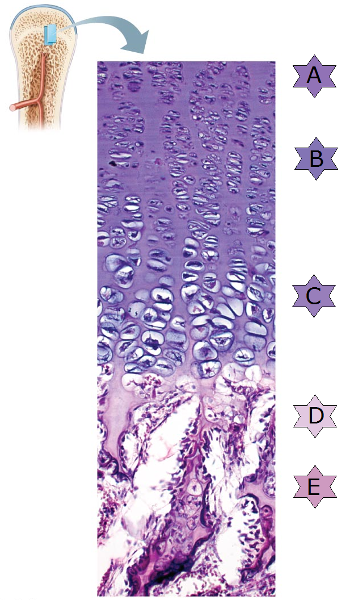
Identify the stage of long bone growth at the epiphyseal plate indicated by "C."
- Hypertrophic zone
- Calcification zone
- Proliferation zone
- Ossification zone
A
Match the following descriptions of the important functions of bone: Support
- Supports the body and cradles its soft organs
- You Were Sure and incorrect
- Surrounds the brain, spinal cord, and heart
- Helps to regulate insulin secretion, glucose homeostasis, and energy expenditure
- As a result, we can walk, grasp objects, and breathe
- A source of energy for the body, is stored in bone cavities
A
Correctly match the term and description: Epiphyseal plate
- Site of length increase in long bones
- Process of long bone development
- Secondary ossification center
- Primary ossification center
C
Match the description to the correct answer: Bone with a complex shape
- Irregular bone
- Sesamoid bone
- Flat bone
- Short bone
- Long bone
A
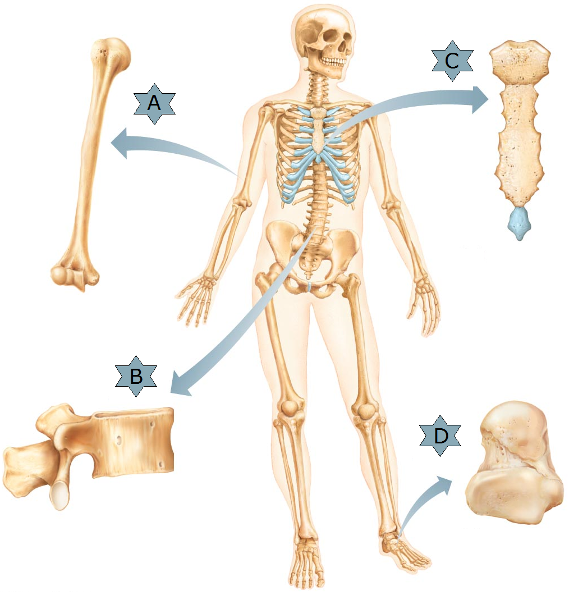
Identify the general class of bone indicated by "C."
- Long bone (humerus)
- Flat bone (sternum)
- Short bone (talus)
- Irregular bone (vertebra)
B
Match the following descriptions of the important functions of bone: Triglyceride (fat) storage
- Helps to regulate insulin secretion, glucose homeostasis, and energy expenditure
- Surrounds the brain, spinal cord, and heart
- Supports the body and cradles its soft organs
- A source of energy for the body, is stored in bone cavities
- As a result, we can walk, grasp objects, and breathe
D
Large rounded projection, may be roughened.
- tuberosity
- crest
- trochanter
- line
A
Narrow ridge of bone; usually prominent
- tuberosity
- crest
- trochanter
- line
B
Very large, blunt, irregularly shaped process
- Trochanter
- Line
- tubercle
- epicondyle
A
Hydroxyapatite in bone matrix that gives bone its hardness is primarily composed of __________.
- calcium and vitamin D
- calcium and osteocytes
- calcium and phosphates
- calcium and osteoclasts
C
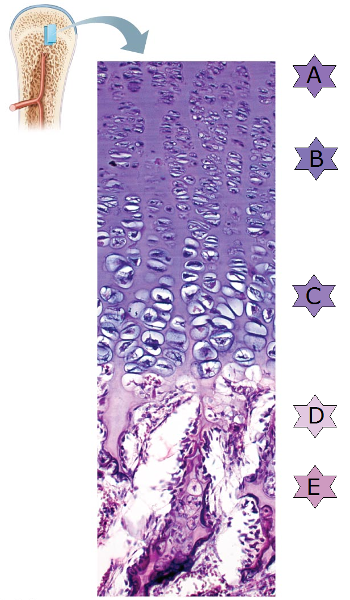
Match the description to the correct stage of intramembranous ossification: Formation of compact bone plates and red marrow
- stage 1
- stage 2
-
stage 3
- stage 4
C
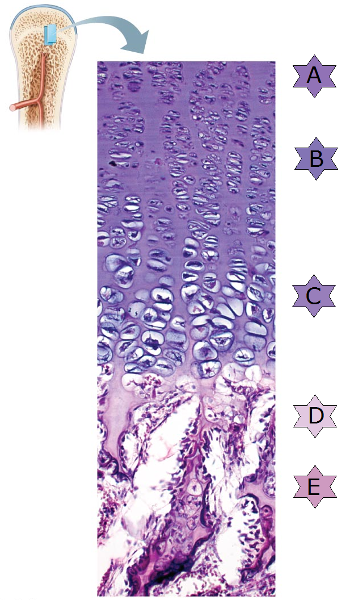
Match the description to the correct stage of intramembranous ossification: Formation of compact bone plates and red marrow
- stage 1
- stage 2
-
stage 3
- stage 4
D